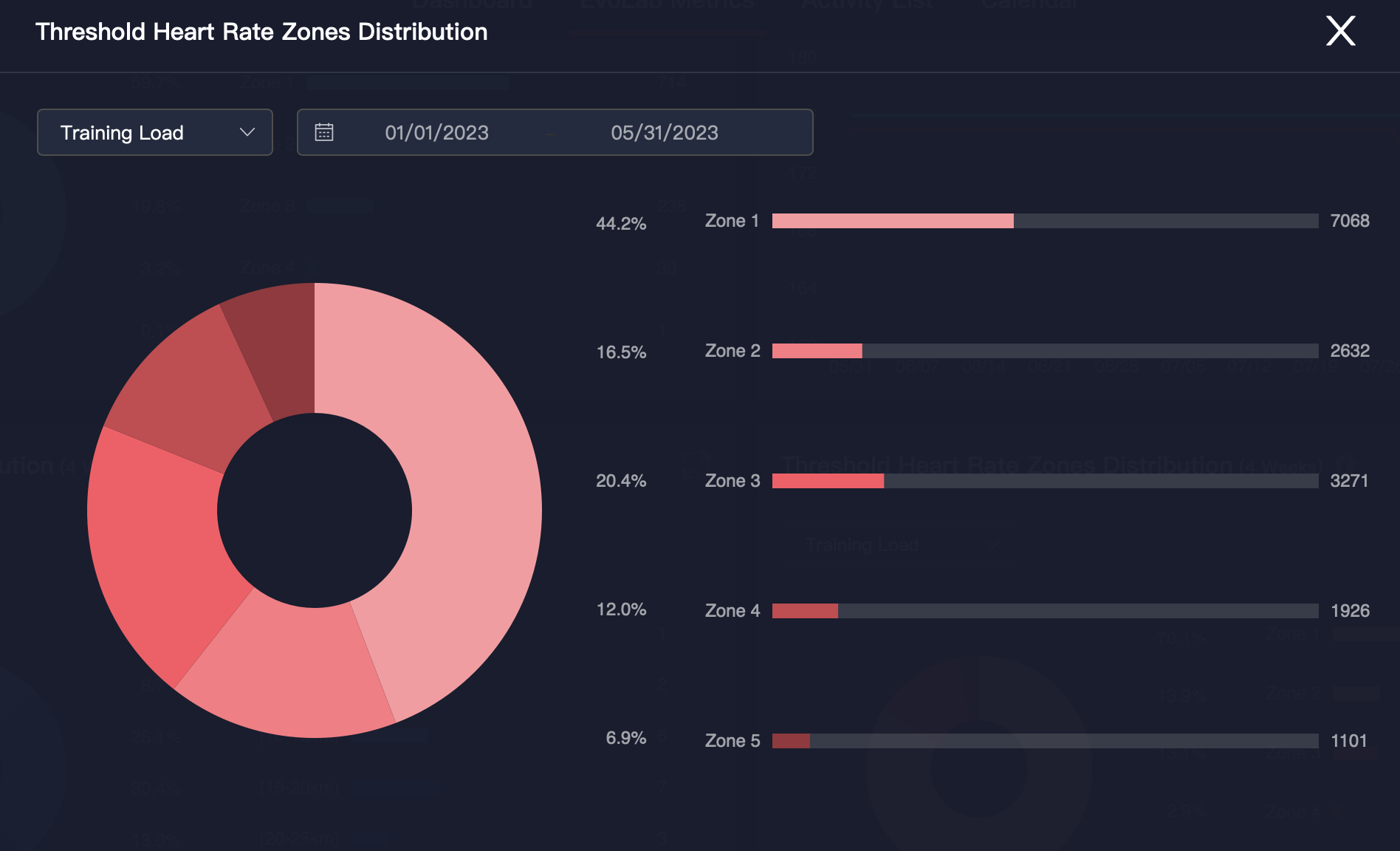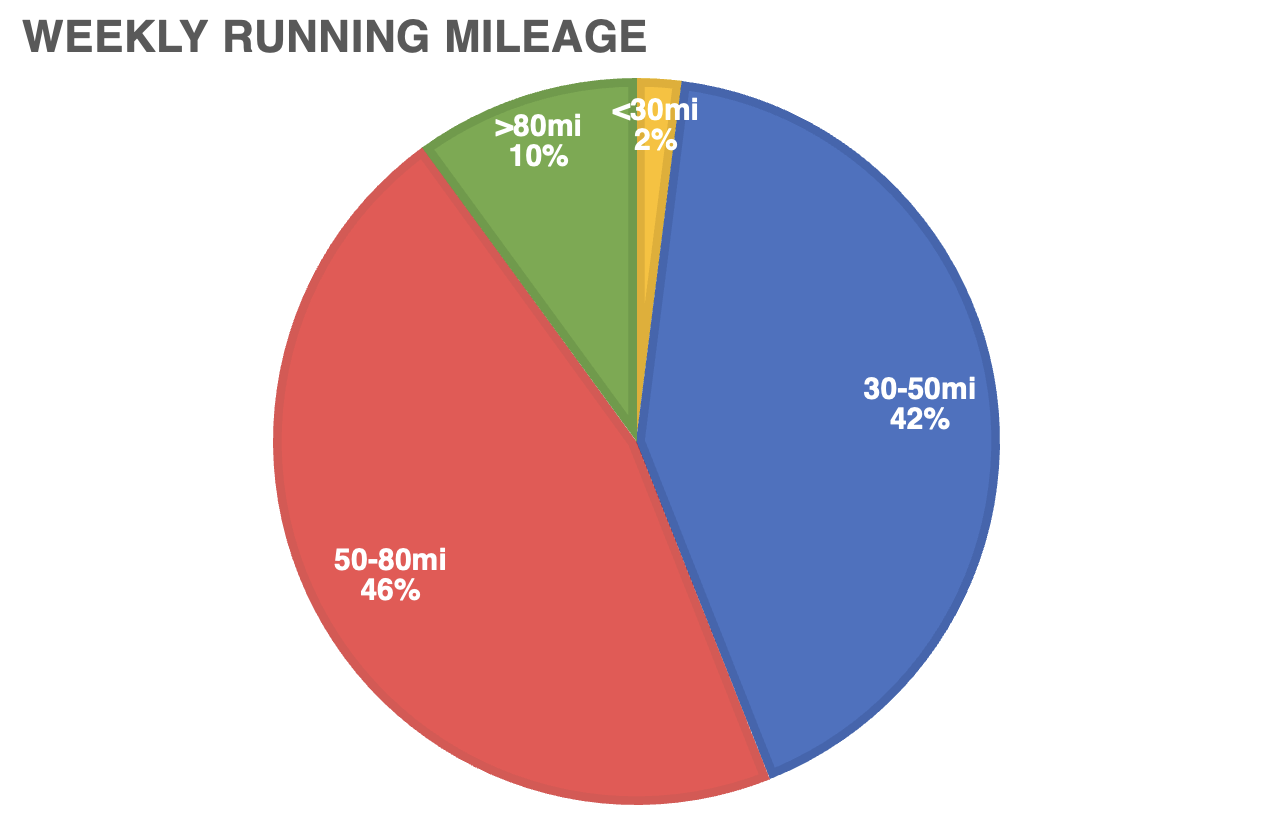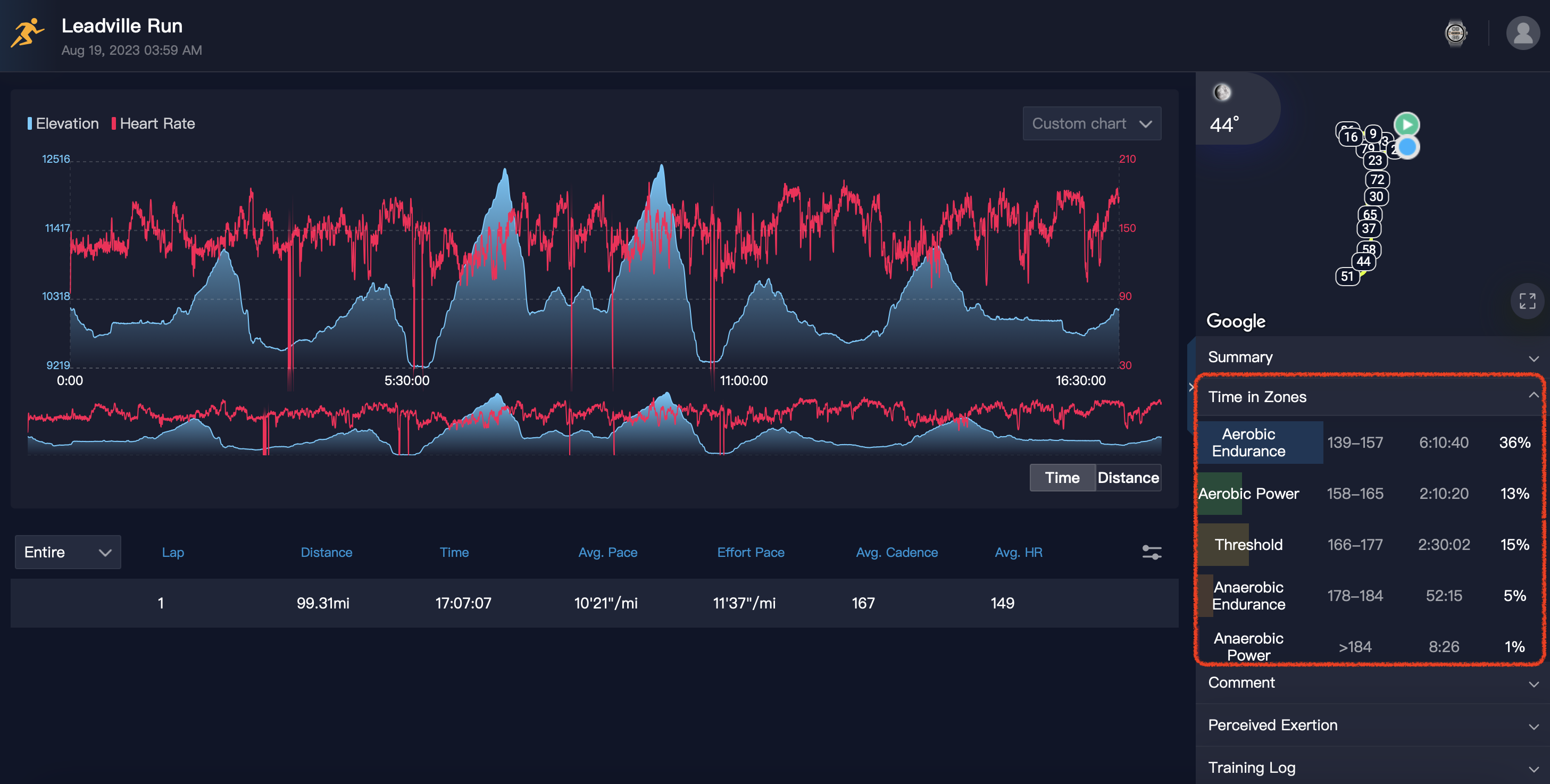Leadville, Colorado, located at 10,152 ft, is home to the Leadville Trail Series and the infamous Leadville 100 Run. For the 40th anniversary of the Leadville Trail Series, COROS Coaches have analyzed the data of athletes toeing the start line of this 100-mile iconic race.
For a deep dive into what it takes to finish one of the toughest ultra-marathon races in the world, sit back and relax as COROS guides you through the metrics to hit.
*All data was analyzed by COROS Coaches to provide insights for future athletes (57 athletes submitted their data for review).
Leadville 100 Run 2023 in Numbers
This year, Leadville experienced particularly high temperatures that left athletes with an additional challenge to deal with. Nevertheless, runners pushed through in hopes of earning the Leadville belt buckle. Here are some general numbers from the 2023 Leadville 100 Run.
| Distance | 99.6 miles (measured by COROS device) |
| Elevation Gain | 13,973 ft (measured by COROS device) |
| Date | August 19th, 2023 |
| Location | Leadville, Colorado, USA |
| Total number of runners | 819 (640 men ; 179 female) |
| Finishers | 363 |
| DNF (Did Not Finish) | 456 |
| % of athletes who completed the race in 30 hours | 44% |
| Overall winner time | 17:07:25 |
| Number of athletes below 20:00:00 | 7 (2% of finishers) |

Joey Miuccio, Leadville 100 Run Finisher. Photo credit: Israel Palacio
Training History
In order to successfully complete Leadville 100 Run under the 30-hour cutoff time, athletes have no choice but to put in the work several months prior to race day. Let's dive into the training history of these 57 athletes from January 2023 to August 2023, starting with COROS EvoLab metrics.
| Peak Base Fitness (Jan 2023 - Aug 2023) | 156 avg (min 104 / max 276) |
| Avg highest weekly training load (January to August 2023) | 1389 avg (min 989 / max 2546) |
| Peak threshold pace (August 2023) | 6'53" avg (min 5'58" / max 8'12") min/mile |
| Peak Running Fitness (August 2023) | 87.0 avg (min 72.1 / max 94.5) |
Base Fitness
Base Fitness allows athletes to monitor their fitness improvements over time as they build for a race. During our analysis, a few interesting points presented themselves. Below are averages for 2023 Leadville athletes.
- Their Base Fitness on January 1st 2023 was on average 100.
- Athletes completed a slow and constant Base Fitness build-up to 160 until August, at which point we can notice a decrease.
- We can see a decrease in Base Fitness to 130 in the last 2 weeks prior the race, which can be explain by a taper.

COROS Coaches Insights. Most athletes will begin their training season with a fairly low Base Fitness. They are well recovered and ready to build up to roughly 160 Base Fitness during their peak season. A 2-week taper was used on average resulting in an Intensity Trend of -20 (performance zone) leading up to race day.
Weekly Training Load
Weekly Training Load (TL) is an essential tool for athletes to monitor their training and adjust it based on volume and intensity. Here are some highlights from Leadville athletes during the training season.
- Their weekly TL on January 1st was on average 700.
- Athletes completed a slow and constant build-up (including recovery weeks) to 1400 until June, at which point we can notice a plateau until August.
- Similar to Base Fitness, we can see a decrease to 800 during their taper, which corresponds to almost 50% in their weekly TL during peak season.

COROS Coaches Insights. After the training load build-up, athletes will plateau 1-2 months prior to race day and focus on specific training. For Leadville, a specific training would focus on higher volume of low-intensity sessions. During taper, athletes have decreased their training load to allow for an optimal recovery prior to race day.
Sneak Peak into the Leadville 2023 Champion's Data
Prior to Leadville, the 2023 champion focused on having a wide range of training intensity from January to June 2023 (left image) while switching to a high-volume low-intensity training (right image) coming closer to race day. This strategy allows the athlete to replicate the race demands in terms of intensity distribution.

HR Zones Distribution (January to June 2023)

HR Zones Distribution (2 months prior to race day)
Race Strategy
Leadville 100 Run is known to be a challenging out-and-back course at high altitude. We asked athletes several questions regarding their race strategy specifically for this race. Let's dive into how athletes have managed their weekly running volume as well as their acclimatization to altitude leading up to race day.
Altitude Training
Leadville takes place on one of the highest ultra-courses in the world. There is therefore a good chance that runners toeing the start line are not generally acclimatized to this altitude. We asked athletes about their altitude training strategy, and here are our findings:
- 51% of athletes did not incorporate any altitude training prior to Leadville.
- 34% of athletes incorporated more than 2 weeks of altitude training.

COROS Coaches Insights. At 10,000+ft, VO2max and intensity thresholds decrease by roughly 20% during exercise. It takes about 2 weeks of exposure to altitude to reach normative values. Therefore, we can assume that 66% of athletes competed with some altitude deficiencies. For any race above 7,000ft, be aware that you may experience altitude sickness symptoms during exercise for the first few days if you are not acclimatized.
Weekly Running Mileage
While Leadville 100 Run is a prestigious race, only 41% of athletes had officially covered this distance before. We therefore decided to dive deeper into their weekly running mileage during their peak season (June to August 2023). Here is what we found:
- Only 2% of athletes have been covering less than 30 miles/week in the months coming up to race day.
- 56% of athletes covered more than 50 miles per week as a benchmark leading up to Leadville.

COROS Coaches Insights. While weekly running mileage remains a personal metric that may be influenced by an athlete's schedule or their local terrain, a general rule of thumb consists of being able to run 80-100% of the race distance in a week during peak season. For Leadville, athletes should aim to cover 80-100 miles during 1-2 weeks during peak season (June to August 2023) while maintaining a slightly lower but consistent weekly running mileage leading up to it.
Sneak Peak Into the Leadville 2023 Champion's Data
The 2023 Leadville Champion averaged roughly 70-80 miles per week from March to August 2023 with a high-volume week of 93 miles during peak season (July 2023). Again, this strategy allows athletes to follow a training plan that is highly specific to the race demands and condition their body for the high volume that the race will inflict.

Race Performance
This year, Leadville 100 Run did not spare athletes with a high temperature throughout the day. Nevertheless, athletes have been able to keep their HR below Aerobic Power COROS (Zone 2) for on average 85% of the race while limiting to 8% their time at threshold or above, which allowed them to sustain the intensity throughout.

COROS Coaches Insights. It is quite common to see that the longer the race, the more time athletes spend in Aerobic Endurance (Zone 1) or below. This trend can be explained by the body being able to function at almost full capacity and regenrate itself at this intensity by using mainly aerobic resources. As an athlete, finding yourself at Threshold (Zone 3) or above for too long means that your body uses energy that will not be able to regenerate later on during the race, putting yourself at risk of exhaustion and other physiological symptoms.
Sneak Peak Into the Leadville 2023 Champion's Data
The Leadville 2023 Champion completed the race with a slight difference in their HR Zones Distribution. Compared to the average data collected above, this athlete spent only 66% of the race at Aerobic Endurance (Zone 1) or below, and 21% at threshold (Zone 3) or above. While we would not advise on following such a high-intensity distribution, this athlete successfully managed the intensity throughout the race by taking it easy on uphills (lower HR) and pushing harder on downhills (higher HR).

Post-Race Feedback
It is safe to assume that with an overall finish rate of 44%, Leadville 100 Run throws some major challenges to athletes out there. After the race, we asked athletes for some subjective feedback for them to reflect on their accomplishments.
"If you had to pick the biggest challenge you had to face during the race, what would it be?"

Anatomical (e.g., muscular fatigue, injury); Physiological (e.g., dehydration, gastrointestinal issues); Logistical (e.g., equipment, crew); Environmental (e.g., altitude)
COROS Coaches Insights. While muscular fatigue always remains a major factor of long-distance races, the physiological component seems to have impacted the majority of athletes throughout the race. Since athletes spend roughly 24 consecutive hours of exercise, they have to continuously take care of their body while running in the mountains. This situation provides countless opportunities for them to make even the slightest mistake and lead their body towards a negative spiral that is often very hard to come back from unless they stop physical activity.
"What would be the one aspect you would change to be better prepared?"
- Prolong altitude exposure prior to race day
- Increase fluid intake
- Increase training volume during peak season
COROS Coaches Insights. While data is beneficial to point out certain trends in training, those top 3 aspects to change from athletes really highlight the subjective component of racing. In preparation for any race, it is crucial to learn the specific race demands and customize your training based on them.
Conclusion
Training plays a major role when it comes to race performance. However, the optimal training periodization can be challenging to schedule by ourselves. Access to a coach leading up to major races such as Leadville can be beneficial for athletes to dial in their training and optimize those subjective variables. As a COROS customer, you have free access to us, COROS Coaches, to talk about your training strategy and reach your training goals in a more efficient manner.
Feel free to email us at Coach@COROS.com to talk with a COROS Coach regarding your training!

/filters:quality(90)/fit-in/970x750/coros-web-faq/upload/images/d4c634cf1f03c7c8a2e9b0dcdd7408e3.png)





